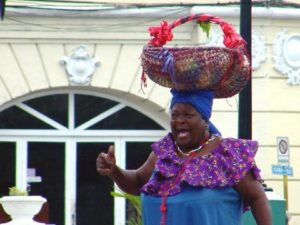LOS “PREGONES” IN CUBA MORE THAN A COMMERCIAL CALL, IT IS A TRADITION
Typical like the royal palm in Cuba are the proclamations, that peculiar way of advertising products in the streets, in a poetic, humorous, and sometimes musical way. Under the hot sun or a downpour, and from January to December, on foot, by bicycle, or driving a wheelbarrow, the town criers pass by every day, with the most diverse and even unusual offers.
SELLERS, both young and old, men and women, are at the same time private workers, sales promoters, and bards, whose advertisements abound with similes, metaphors, and the most incredible figures of language, could leave the great poets of the century speechless. XIX in Latin America.
In a particular way, in the neighborhoods of Havana, you can hear everything in terms of the proclamation, so much so that today Saturday a seller of flowers and other things shouted: “Bathe with white flowers / that serve as dispossession / to get rid of dengue, the curse, and the lice ”.
The woman advertised “cleaning products,” while she offered vicarious flowers, branches of a bush known as victor, as well as live jicoteas (turtles) and dried green coconuts.
The incredible thing is that there is always someone who buys such products for them, they can well fumigate the house and keep their hair clean by using shampoo.
For many Cubans who have inherited the mythology of African slaves, “dispossession” is not equivalent to looting someone, but to hitting the body with certain flowers and branches to “cleanse themselves of bad spiritual influences.”
Another young salesman said “I buy old ones, but in good condition”, while he was carrying a wheelbarrow with several electric irons from the last century, which he planned to repair and resell at a higher price.
Some town criers use a humorous style while advertising the most discordant products and services, such as one that exclaimed: “I sell a gun … to weld metals”, and “I can take care of an old woman if I inherit her house.”
Other itinerant shopping poets offer to mend hearts and restore joy while offering romantic music records and double bed mattress repair services.
“I buy old televisions and empty perfume bottles” are other demands of some town criers with wheelbarrows, who in turn offer bottles of home fragrance, food, vegetables, and spare parts for Soviet-era alarm clocks.
What to say about “the good guava” that some people proclaim when they try to sell a red mix of beet with burro banana, in the form of a bar.
THE PREGON ARISES IN HISTORY
Although it is not known when the proclamation arose, it is assumed that it was thousands of years ago, when someone wanted to sell merchandise or offer a service, explained the Cuban historian Ciro Bianchi. Later, when an employee began to move and sell it on the streets, the traveling advertisement began and all that led to an official proclamation, where the city made known the news of greatest interest, added Bianchi.
“In Cuba, there have always been town criers, but after 1959 private businesses closed and almost disappeared, except for those that advertised the sale of flowers,” said the journalist.
With the government’s authorization for self-employment, street vendors reappeared, with proposals as dissimilar as their proclamations, Bianchi said.
“I remember that as a child an old man who sold Morón torticas (sweet Creole made from wheat flour) used to pass by my house, and said:“ A kilito (cent) the Morón torticas, how delicious they are; Morón’s torticas are a sensation by the pound, ”the Cuban journalist recalled.
THE SALE OF GOODS
In the 1950s, the profession of the traveling salesman was common in Cuba, people who went from town to town carrying various merchandise, whose work, although it was not announced at all voices, derived from the neighborhood town crier.
For Cubans, this vendor provides a service to the community, since people can buy a product or solve a problem at their doorstep, without having to go to a market or to another place.
The same in the morning as in the afternoon, Havanans can hear whistles that identify the postman and the baker, while the knife and scissors grinder and the ice cream vendor announce themselves with melodies produced by music boxes.
“Good size, good taste, the tamales at a good price,” shouts the seller of that corn dough cooked inside the cereal itself, while a colleague offers bottles of bleach “that cleans everything, even the conscience.”
In this way, the proclamation, without being indigenous to Cuba, has taken its own national form and has become part of the cultural and social identity of the Cuban.
In Cuba, the proclamation is not only a commercial necessity but a tradition, and it has mutated to adapt to new times, where technology is part of everyday life, which is why some are accompanied by speakers and music.
Without a doubt, the most famous Cuban proclamation of all time, and the first success of the island’s music in the world, was the proclamation “El Manisero” by the composer Moisés Simons (Havana, 1889 – Madrid, 1945) and immortalized in the incomparable voice of Rita Montaner.
In 1928, this composer, pianist, and orchestra, and theater director wrote the immortal proclamation on a napkin, which was included in the film The Cuban Song, by Metro Goldwyn Mayer, and in the American television program “Nace a star”.
“Maní, manicero llego … little house does not lie down to sleep / without eating a peanut cone … The manicero se va, says this song that 90 years later Cubans and foreigners continue to like for its cheerful and contagious rhythm.
Later they were followed by other proclamations-songs that were also very popular, such as ‘El panquelero’ (seller of the sweet known as panqué) and Los ‘Tamalitos de Olga’, but never at the level of “El Manicero”.
LOS “PREGONES” EN CUBA MAS QUE UN LLAMADO MERCANTIL ES UNA TRADICION
Típicos como la palma real son en Cuba los pregones, esa forma tan peculiar de ir anunciando productos por las calles, de forma poética, jocosa y a veces musical. Bajo ardiente sol o un aguacero, y de enero a diciembre, a pie, en bicicleta o guiando una carretilla, a diario pasan los pregoneros, con las más diversas y hasta insólitas ofertas.
LOS VENDEDORES, tanto jóvenes como ancianos, hombres y mujeres, son a la vez trabajadores privados, promotores de venta y bardos, en cuyos anuncios abundan los símiles, metáforas y las más increíbles figuras del lenguaje, podrían dejar boquiabiertos a los grandes poetas del siglo XIX en Iberoamérica.
De modo particular, en los barrios de La Habana puede escucharse de todo en materia de pregón, tanto es así que hoy sábado una vendedora de flores y otras cosas gritaba: “Báñate con flores blancas/ que sirven como despojo/ para librarte del dengue, el maleficio y los piojos”.
La mujer anunciaba “productos de limpieza”, mientras ofertaba flores de vicaria, ramas de un arbusto conocido como vencedor, así como jicoteas vivas (tortugas) y cocos verdes y secos.
Lo increíble es que siempre hay quien les compre tales productos, bien pueden fumigar la casa y mantener sus cabellos limpios mediante el uso de champú.
Para muchos cubanos que han heredado la mitología de los esclavos africanos, el “despojo” no equivale a saquear a alguien, sino a golpearse el cuerpo con ciertas flores y ramas para “limpiarse de malas influencias espirituales”.
Otro joven vendedor decía “compro viejas, pero en buen estado” , mientras llevaba una carretilla con varias planchas eléctricas del siglo pasado, las cuales pensaba reparar y revender a mayor precio.
Algunos pregoneros usan un estilo jocoso, a la vez que anuncian los productos y servicios más discordantes, como uno que exclamaba: “Vendo una pistola… para soldar metales”, y “puedo cuidar a una anciana, si heredo su casa”.
Otros poetas ambulantes de la compra-venta se ofrecen a reparar corazones y devolver la alegría, mientras ofertan discos de música romántica y servicios de reparación de colchones de cama matrimonial.
“Compro televisores viejos y pomos de perfume vacíos” son otras demandas de algunos pregoneros con carretillas, que a su vez ofrecen botellas de aromatizante para el hogar, viandas, legumbres y piezas de repuesto para relojes despertadores de la era soviética.
Qué decir de “la buena guayaba” que pregonan algunos, cuando tratan de vender una mezcla colorada de remolacha con plátano burro, en forma de barra.
SURGE EL PREGON EN LA HISTORIA
Aunque no se sabe cuándo surgió el pregón, se supone que fue hace miles de años, cuando alguien quiso vender una mercancía u ofertar un servicio explicó el historiador cubano Ciro Bianchi. Después, cuando un empleado empezó a moverse y a venderla por las calles, comenzó el anuncio ambulante y todo eso dio a pie a un pregón oficial, donde la ciudad hacía saber las noticias de mayor interés, añadió Bianchi.
“En Cuba hubo pregoneros desde siempre, pero después de 1959 cerraron los negocios privados, y casi desaparecieron, salvo los que anunciaban la venta de flores”, dijo el periodista.
Con la autorización del gobierno para el trabajo por cuenta propia, reaparecieron los vendedores ambulantes, con propuestas tan disímiles como sus pregones, señaló Bianchi.
“Yo recuerdo que de niño pasaba por mi casa un anciano que vendía torticas de Morón (dulce criollo de harina de trigo), y decía: “A kilito (centavo) las torticas de Morón, que ricas son; a kilito las torticas de Morón, son sensación”, recordó el periodista cubano.
LA VENTA DE MERCANCIAS
En la década de 1950 era común en Cuba el oficio de viajante de comercio, personas que iban de pueblo en pueblo llevando diversas mercancías, cuya labor, aunque no se anunciaba a toda voz, derivó del pregonero de barrios.
Para los cubanos, este vendedor presta un servicio a la comunidad, pues las personas pueden adquirir un producto o resolver un problema en la puerta de sus casas, sin tener que trasladarse a un mercado o a otro lugar.
Lo mismo en la mañana que de tarde, los habaneros pueden escuchar silbatos que identifican al cartero y al panadero, mientras que el amolador de cuchillos y tijeras y el vendedor de helados se anuncian con melodías producidas por cajas de música.
“Buen tamaño, buen sabor, a buen precio los tamales”, grita la vendedora de esa masa de maíz cocinada dentro de las hojas del propio cereal, mientras un colega oferta botellas de cloro “que limpia todo, hasta la conciencia”.
De este modo, el pregón, sin ser autóctono de Cuba, ha tomado su propia forma nacional y se ha convertido en parte de la identidad cultural y social del cubano.
En Cuba, el pregón no sólo es una necesidad mercantil sino una tradición, y ha mutado para adaptarse a los nuevos tiempos, donde la tecnología forma parte de la cotidianidad, por eso algunos se acompañan de bocinas y de música.
Sin duda, el pregón cubano más famoso de todos los tiempos, y primer éxito de la música de la isla en el mundo, fue el pregón “El Manisero” del compositor Moisés Simons (La Habana, 1889 – Madrid, 1945) e inmortalizado en la imcomparable voz de Rita Montaner.
En 1928 este compositor, pianista y director de orquesta y teatro escribió sobre una servilleta el inmortal pregón, que fue incluido en el filme The Cuban Song (La canción cubana), de la productora Metro Goldwyn Mayer, y en el programa televisivo estadounidense “Nace una estrella”.
“Maní, manicero llegó… caserita no te acuestes a dormir/sin comerte un cucurucho de maní… El manicero se va” , dice esta canción que 90 años después sigue gustando a cubanos y extranjeros por su alegre y contagioso ritmo.
Luego le siguieron otros pregones-canciones que también fueron muy populares, como ‘El panquelero’ (vendedor del dulce conocido como panqué) y Los ‘Tamalitos de Olga’, pero nunca a la altura de “El Manicero”.
Agencies/ Xinhua/ Gretel Heredia/ Noemí Galbán/ Internet Photos/ Arnoldo Varona/ www.TheCubanHistory.com
THE CUBAN HISTORY, HOLLYWOOD.











